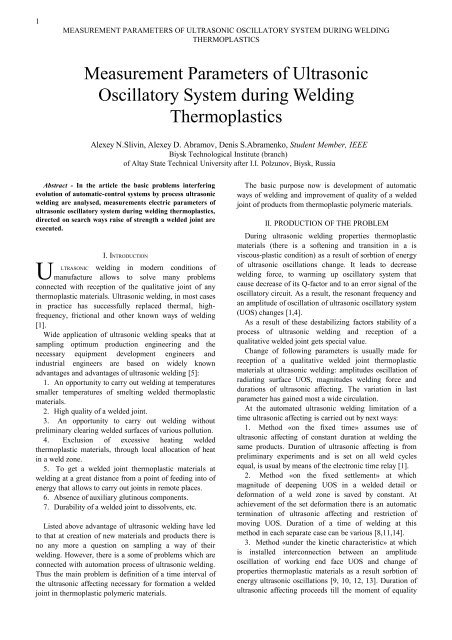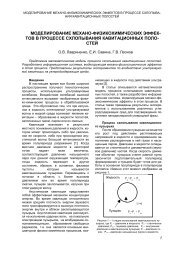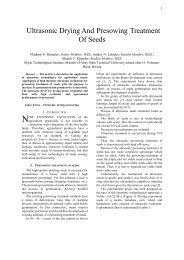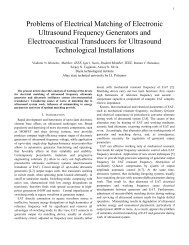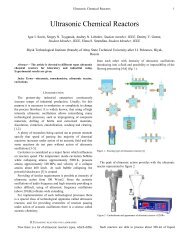Measurement Parameters of Ultrasonic Oscillatory System during ...
Measurement Parameters of Ultrasonic Oscillatory System during ...
Measurement Parameters of Ultrasonic Oscillatory System during ...
You also want an ePaper? Increase the reach of your titles
YUMPU automatically turns print PDFs into web optimized ePapers that Google loves.
1MEASUREMENT PARAMETERS OF ULTRASONIC OSCILLATORY SYSTEM DURING WELDINGTHERMOPLASTICS<strong>Measurement</strong> <strong>Parameters</strong> <strong>of</strong> <strong>Ultrasonic</strong><strong>Oscillatory</strong> <strong>System</strong> <strong>during</strong> WeldingThermoplasticsAlexey N.Slivin, Alexey D. Abramov, Denis S.Abramenko, Student Member, IEEEBiysk Technological Institute (branch)<strong>of</strong> Altay State Technical University after I.I. Polzunov, Biysk, RussiaAbstract - In the article the basic problems interferingevolution <strong>of</strong> automatic-control systems by process ultrasonicwelding are analysed, measurements electric parameters <strong>of</strong>ultrasonic oscillatory system <strong>during</strong> welding thermoplastics,directed on search ways raise <strong>of</strong> strength a welded joint areexecuted.UI. INTRODUCTIONLTRASONIC welding in modern conditions <strong>of</strong>manufacture allows to solve many problemsconnected with reception <strong>of</strong> the qualitative joint <strong>of</strong> anythermoplastic materials. <strong>Ultrasonic</strong> welding, in most casesin practice has successfully replaced thermal, highfrequency,frictional and other known ways <strong>of</strong> welding[1].Wide application <strong>of</strong> ultrasonic welding speaks that atsampling optimum production engineering and thenecessary equipment development engineers andindustrial engineers are based on widely knownadvantages and advantages <strong>of</strong> ultrasonic welding [5]:1. An opportunity to carry out welding at temperaturessmaller temperatures <strong>of</strong> smelting welded thermoplasticmaterials.2. High quality <strong>of</strong> a welded joint.3. An opportunity to carry out welding withoutpreliminary clearing welded surfaces <strong>of</strong> various pollution.4. Exclusion <strong>of</strong> excessive heating weldedthermoplastic materials, through local allocation <strong>of</strong> heatin a weld zone.5. To get a welded joint thermoplastic materials atwelding at a great distance from a point <strong>of</strong> feeding into <strong>of</strong>energy that allows to carry out joints in remote places.6. Absence <strong>of</strong> auxiliary glutinous components.7. Durability <strong>of</strong> a welded joint to dissolvents, etc.Listed above advantage <strong>of</strong> ultrasonic welding have ledto that at creation <strong>of</strong> new materials and products there isno any more a question on sampling a way <strong>of</strong> theirwelding. However, there is a some <strong>of</strong> problems which areconnected with automation process <strong>of</strong> ultrasonic welding.Thus the main problem is definition <strong>of</strong> a time interval <strong>of</strong>the ultrasonic affecting necessary for formation a weldedjoint in thermoplastic polymeric materials.The basic purpose now is development <strong>of</strong> automaticways <strong>of</strong> welding and improvement <strong>of</strong> quality <strong>of</strong> a weldedjoint <strong>of</strong> products from thermoplastic polymeric materials.II. PRODUCTION OF THE PROBLEMDuring ultrasonic welding properties thermoplasticmaterials (there is a s<strong>of</strong>tening and transition in a isviscous-plastic condition) as a result <strong>of</strong> sorbtion <strong>of</strong> energy<strong>of</strong> ultrasonic oscillations change. It leads to decreasewelding force, to warming up oscillatory system thatcause decrease <strong>of</strong> its Q-factor and to an error signal <strong>of</strong> theoscillatory circuit. As a result, the resonant frequency andan amplitude <strong>of</strong> oscillation <strong>of</strong> ultrasonic oscillatory system(UOS) changes [1,4].As a result <strong>of</strong> these destabilizing factors stability <strong>of</strong> aprocess <strong>of</strong> ultrasonic welding and reception <strong>of</strong> aqualitative welded joint gets special value.Change <strong>of</strong> following parameters is usually made forreception <strong>of</strong> a qualitative welded joint thermoplasticmaterials at ultrasonic welding: amplitudes oscillation <strong>of</strong>radiating surface UOS, magnitudes welding force anddurations <strong>of</strong> ultrasonic affecting. The variation in lastparameter has gained most a wide circulation.At the automated ultrasonic welding limitation <strong>of</strong> atime ultrasonic affecting is carried out by next ways:1. Method «on the fixed time» assumes use <strong>of</strong>ultrasonic affecting <strong>of</strong> constant duration at welding thesame products. Duration <strong>of</strong> ultrasonic affecting is frompreliminary experiments and is set on all weld cyclesequal, is usual by means <strong>of</strong> the electronic time relay [1].2. Method «on the fixed settlement» at whichmagnitude <strong>of</strong> deepening UOS in a welded detail ordeformation <strong>of</strong> a weld zone is saved by constant. Atachievement <strong>of</strong> the set deformation there is an automatictermination <strong>of</strong> ultrasonic affecting and restriction <strong>of</strong>moving UOS. Duration <strong>of</strong> a time <strong>of</strong> welding at thismethod in each separate case can be various [8,11,14].3. Method «under the kinetic characteristic» at whichis installed interconnection between an amplitudeoscillation <strong>of</strong> working end face UOS and change <strong>of</strong>properties thermoplastic materials as a result sorbtion <strong>of</strong>energy ultrasonic oscillations [9, 10, 12, 13]. Duration <strong>of</strong>ultrasonic affecting proceeds till the moment <strong>of</strong> equality
2MEASUREMENT PARAMETERS OF ULTRASONIC OSCILLATORY SYSTEM DURING WELDINGTHERMOPLASTICS<strong>of</strong> voltages and currents flowing through UOS with areference quantity certain by practical consideration.At use <strong>of</strong> the circuit diagram <strong>of</strong> welding «on the fixedtime» the probability formation <strong>of</strong> a poor-quality weldedjoint is defined by following parameters:1. Instability <strong>of</strong> a resonant frequency and amplitude <strong>of</strong>oscillation UOS;2. Deviation <strong>of</strong> initial thickness <strong>of</strong> welded materialsfrom optimum;3. Instability <strong>of</strong> weld conditions (temperature <strong>of</strong> awaveguide and magnitude welding force).4. Impurity <strong>of</strong> welded surfaces.Not large changes <strong>of</strong> parameters <strong>of</strong> a welding regime,geometry <strong>of</strong> details and properties <strong>of</strong> materials can lead tothat the demanded time <strong>of</strong> welding will appear more orless time installed by the relay. Thus in the first case willbe observed skin weld, in second - burn weld. It instability<strong>of</strong> the results gained at welding on the fixed time speaks.Improvement <strong>of</strong> quality in this case are aimed to attaindue to maintenance <strong>of</strong> a constancy <strong>of</strong> parameters <strong>of</strong> awelding regime, however it considerably complicates adesign <strong>of</strong> the equipment.Unlike the circuit diagram <strong>of</strong> welding «on the fixedtime» at which sampling <strong>of</strong> duration <strong>of</strong> a welding time isnot connected absolutely not with education <strong>of</strong> a weldedjoint, the circuit design <strong>of</strong> welding «on the fixedsettlement» is partially connected with kinetics <strong>of</strong>education <strong>of</strong> a welded joint. In this case the probability <strong>of</strong>implementation <strong>of</strong> a poor-quality welded joint is definedby instability <strong>of</strong> initial thickness <strong>of</strong> welded materials.Use <strong>of</strong> a welding method «on the fixed settlement»assumes the certain deformation <strong>of</strong> a zone <strong>of</strong> a seam, thatsometimes happens is inadmissible owing to a decline <strong>of</strong> apackaging <strong>of</strong> a product. The basic deficiencies <strong>of</strong> a way <strong>of</strong>management process <strong>of</strong> ultrasonic welding («on the fixedsettlement») [8,11,14] is necessity <strong>of</strong> recustomizing <strong>of</strong> theequipment for realization <strong>of</strong> welded joints from various onproperties and thickness <strong>of</strong> materials, and also presence <strong>of</strong>various sensors (end switch, optical, end-<strong>of</strong>-strokesensors).At ultrasonic welding with a batching <strong>of</strong> energy underthe kinetic characteristic the information on aphysicomechanical condition <strong>of</strong> welded materials is used[1]. During ultrasonic welding there is a s<strong>of</strong>tening andtransition <strong>of</strong> a material in a plastic condition, magnitude<strong>of</strong> a static compression pressure changes. Therefore thesquare <strong>of</strong> contact <strong>of</strong> a welded material and welding toolUOS changes. There is a change <strong>of</strong> an amplitude <strong>of</strong>oscillation <strong>of</strong> oscillatory system and as consequencechange <strong>of</strong> a current, a voltage, a phase angle betweenthem, the power consumed UOS <strong>during</strong> welding. Thepublications <strong>of</strong> authors [6,7,9,10,12] connected withmeasurements on the electric side <strong>of</strong> the generator <strong>of</strong>voltages and currents flowing through UOS, matchingspeed or amplitude <strong>of</strong> ultrasonic oscillations in a material,to a sign on a speed-up <strong>of</strong> a straining [8,11,14] materialsunder a waveguide and the high-frequency energy [12]consumed UOS are known. In the specified waysmeasurement <strong>of</strong> the signal proportional to an amplitude <strong>of</strong>oscillation and management <strong>of</strong> process <strong>of</strong> welding makeby comparison <strong>of</strong> signals with a reference quantity. Thusa batching <strong>of</strong> energy carry out with high repeatability <strong>of</strong>process.The basic deficiencies <strong>of</strong> these ways <strong>of</strong> management isthat the <strong>of</strong>fered criterion <strong>of</strong> definition <strong>of</strong> transition <strong>of</strong> amaterial in a plastic condition <strong>during</strong> ultrasonic weldingis not to constants. Application <strong>of</strong> big static pressures<strong>during</strong> ultrasonic welding lead to a damping <strong>of</strong> workingtool UOS, decrease <strong>of</strong> an amplitude <strong>of</strong> oscillation andimpossibility <strong>of</strong> the control <strong>of</strong> process ultrasonic welding.Besides <strong>during</strong> welding there is a nonlinear changeproperties <strong>of</strong> polymeric materials, heating UOS, decrease<strong>of</strong> its resonant frequency and an amplitude <strong>of</strong> oscillation<strong>during</strong> welding.Because any <strong>of</strong> ways <strong>of</strong> management used now process<strong>of</strong> ultrasonic welding to the full does not consider change<strong>of</strong> parameters UOS, it is necessary to solve followingproblems:1. To execute measurements <strong>of</strong> electric parametersUOS <strong>during</strong> ultrasonic welding.2. To define the effect, changing properties <strong>of</strong> weldedmaterials on parameters UOS.3. To research effect welding pressure on electricparameters UOS.III. RESULTS OF MEASUREMENT OF ELECTRIC PARAMETERS UOSGeneratorf oс , f oпU, I, f, ϕ (I,U)ControlDURING WELDINGAt research <strong>of</strong> process <strong>of</strong> ultrasonic welding it was usedUOS for welding thermoplastic, operating at a frequency<strong>of</strong> 22 kHz, polypropylene weld specimens by thickness <strong>of</strong>1,1 mm, lapped combined.The measuring complex is developed for measurement<strong>of</strong> electric parameters UOS <strong>during</strong> ultrasonic welding. Infigure 1 the block diagram <strong>of</strong> the measuring complex <strong>of</strong>electric parameters UOS is presented.The measuring complex is connected to a diagnosticconnector <strong>of</strong> the ultrasonic generator, and as in "rupture"<strong>of</strong> a cable <strong>of</strong> UOS. Such connection provides anControlMeasuringcomplexComputerU, I, f, ϕ (I,U)DataFig. 1. Block diagram <strong>of</strong> measurement <strong>of</strong> parameters UOS.UOSopportunity <strong>of</strong> measurement <strong>of</strong> parameters followingsignals:
3MEASUREMENT PARAMETERS OF ULTRASONIC OSCILLATORY SYSTEM DURING WELDINGTHERMOPLASTICS1. Signal <strong>of</strong> basic frequency from the setting generatorsets working frequency UOS.2. Feedback signal. Primary transformation <strong>of</strong> a signalis carried out by the internal circuit diagram <strong>of</strong> thegenerator. This signal is used in system <strong>of</strong> AutomaticFrequency control (AFC).3. Voltage on oscillatory system.4. Strength <strong>of</strong> current on oscillatory system.ϕ (U,Os)ϕ (I,U)UI001t, sFig. 2. Electric parameters UOS <strong>during</strong> welding without taking intoaccount effect <strong>of</strong> properties <strong>of</strong> materials (radiation in air).ϕ (U,Os)UIϕ (I,U)ϕ (U,Op)00 Phase 1 Phase 2 Phase 31t, sFig. 3. Electric parameters UOS <strong>during</strong> welding at constant pressure.Ι5 kg0 kg8 kg10 kg15 kg0Fig. 4. Dependence <strong>of</strong> amplitude <strong>of</strong> the current flowing throughpiezoceramic elements UOS <strong>during</strong> welding at various weld pressure.By means <strong>of</strong> these signals it is possible to computefollowing parameters UOS:1. Value <strong>of</strong> a voltage on oscillatory system.1t, s
4MEASUREMENT PARAMETERS OF ULTRASONIC OSCILLATORY SYSTEM DURING WELDINGTHERMOPLASTICS2. Value <strong>of</strong> a current on oscillatory system.3. Oscilation frequency UOS.4. A phase difference <strong>of</strong> a voltage and a current onoscillatory system.5. A phase difference between two any periodic signals(from the basic generator, a feedback, a current or avoltage on oscillatory system).For management <strong>of</strong> job <strong>of</strong> the measuring complex andas recordings and processings <strong>of</strong> the measuredinformation the personal computer is used.Communication is carried out by means <strong>of</strong> protocol RS-232.During ultrasonic welding continuous measurement <strong>of</strong>amplitude current <strong>of</strong> mechanical branch UOS I,amplitudes <strong>of</strong> electric voltage U, a phase angle between avoltage and current φ(I, U), a phase angle between avoltage on oscillatory system and feedback signal φ(I,Os), a phase angle between a voltage and a signal basicfrequencies φ(I, Op) was made (figure 2).In figure 2 dependences <strong>of</strong> electric parameters UOS atan absent material are presented (radiation to air).During welding at an absent material value <strong>of</strong> currentI, voltage U and phase angles φ (I, U), φ (I, Op), φ (I,Os) are saved by constants <strong>during</strong> all period <strong>of</strong> ultrasonicaffecting. In this case parameters UOS remain toconstants, because <strong>of</strong> absence <strong>of</strong> effect on oscillatorysystem, changing properties <strong>of</strong> a welded material <strong>during</strong>welding.Dependences presented in figure 3 illustrate effect <strong>of</strong>changing properties <strong>of</strong> a welded material in a weld zone(a s<strong>of</strong>tening <strong>of</strong> a polymeric material and transition in a isviscous-plastic condition) on electric parametersoscillatory system. There is a change <strong>of</strong> followingmagnitudes: I, U, φ(I, U), φ(I, Os) and φ(I,Op).From dependences presented in figure 3 follows thatprocess <strong>of</strong> welding can be broken into 3 stages:1. Change <strong>of</strong> a welded material from a solid conditionin is viscous-plastic. At this stage there is a decrease <strong>of</strong>value <strong>of</strong> current I and voltage U on oscillatory system,increase in a phase angle between a voltage and a currentφ(I,U), and values <strong>of</strong> phase angles φ(I,Os) and φ(I,Op)remain practically constant.2. The Is viscous-plastic condition. At this stage thereis maximum damping oscillatory system. Values <strong>of</strong>current I and voltage U attain the minimal value, andmagnitude <strong>of</strong> a phase angle between a voltage and acurrent φ(I,U) on oscillatory system attains the maximumvalue.3. Change <strong>of</strong> a welded material from a is viscousplasticcondition in is viscous-fluid. At this stage there isan intensive smelting a material in a weld zone. Excesses<strong>of</strong> the fused material start to be extruded from a weld zonethat reduces welding pressure on oscillatory system. Thereis an increase in value <strong>of</strong> current I and voltage U onoscillatory system, decrease <strong>of</strong> a phase angle between avoltage and current φ(I, U).One <strong>of</strong> key parameters <strong>of</strong> ultrasonic welding is weldingpressure.In figure 4 some dependences <strong>of</strong> the current flowingthrough piezoceramic elements oscillatory system atwelding <strong>of</strong> equal specimens on thickness frompolypropylene at changing welding pressure on a materialare presented.From the presented dependences follows, that, atwelding equal specimens on thickness, curves <strong>of</strong> a currentcan differ essentially from each other. It is connected, first<strong>of</strong> all, with various force <strong>of</strong> welding pressures on weldedmaterials, both <strong>during</strong> the initial moment, and <strong>during</strong> allprocess <strong>of</strong> welding.Carried out researches have shown, that at effect <strong>of</strong> bigwelding pressures there is strong damping UOS owing towhat it is not formed a qualitative welded joint. On theother hand at small welding pressure also it is not formeda qualitative welded joint, owing to insufficient energyforwarded in a weld zone.Thus, for implementation <strong>of</strong> the qualitative joint <strong>of</strong>materials it is necessary to expel effect <strong>of</strong> instabilitywelding pressures at ultrasonic welding, i.e. to expeldistortions <strong>of</strong> curves <strong>of</strong> a current.From the gained results necessity <strong>of</strong> search optimumwelding pressures <strong>during</strong> ultrasonic welding follows.The further jobs will be directed on search <strong>of</strong> optimumparameters <strong>of</strong> ultrasonic welding thermoplastic materials.IV. CONCLUSIONAs a result <strong>of</strong> the spent researches have been solvedfollowing individual problems:1. <strong>Measurement</strong>s <strong>of</strong> electric parameters UOS <strong>during</strong>ultrasonic welding are carried out;2. Effect, changing properties <strong>of</strong> welded materials onparameters UOS is determine;3. Eeffect welding pressures on electric parametersUOS Is researched;4. Optimum regimes for implementation <strong>of</strong> ultrasonicwelding with the maximum effect are installed.5. Criteria <strong>of</strong> automatic determination <strong>of</strong> optimumregimes <strong>of</strong> ultrasonic welding <strong>of</strong> various materials invarious conditions are determined.REFERENCES[1] Volkov S.S., Cherniak B.J. Welding <strong>of</strong> plastic usingultrasound, Chemistry.[2] Volkov S.S., Orlov U.N., Astahova R.N. Weldingand agglutination <strong>of</strong> plastic. М., «Machinery», 1972,128 с .[3] Zaysev K.I., Matsuk L.N. Welding plastic. М.,«Machinery», 1978.[4] Holopov JU.V. <strong>Ultrasonic</strong> welding <strong>of</strong> plastic andmetals. "Mechanical engineering", 1988.[5] Khmelev V.N., Slivin A.N., Barsukov R.V.,Tsyganok S.N., Savin I.I., Shalunov A.V., LevinS.V., Abramov A.D. "Development <strong>of</strong> the New
5MEASUREMENT PARAMETERS OF ULTRASONIC OSCILLATORY SYSTEM DURING WELDINGTHERMOPLASTICSPrinciple <strong>of</strong> Batching <strong>of</strong> Energy at <strong>Ultrasonic</strong>Welding and Creation <strong>of</strong> the Equipment forConnection <strong>of</strong> Thermoplastic Materials", IntrnationalWorkshops and Tutorials on Electron Devices andMaterials EDM'2006: Workshop Proceedings. -Novosibirsk: NSTU, 2006.[6] Patent the USSR №1315341 Control mode <strong>of</strong> aultrasonic welding.[7] Patent the USSR №1627413 Control mode <strong>of</strong> aultrasonic welding.[8] Patent the USSR №176381 Device for ultrasoundwelding plastic.[9] Patent the USSR №550225 Device <strong>of</strong> a proportioning<strong>of</strong> energy at a ultrasonic welding.[10] Patent the USSR №719835 Way <strong>of</strong> management <strong>of</strong>process <strong>of</strong> a ultrasonic welding.[11] Patent the USSR №753664 Device for ultrasonicwelding plastic. / Cherniak B.J., Bokov V.A.,Lyashko F.E, Zvezdin G.A., Tizengauzen А.М..[12] Patent the USSR №996140 Control mode <strong>of</strong> aultrasonic welding / Kozich А.А..[13] RU, patent, 2220917 kl. В 29с 65/08. Method <strong>of</strong>ultrasound welding thermoplastic / Lyashko F.E.,Sokolova O.F.[14] RU, patent, 2229382 kl. В 29 С 65/08. Method <strong>of</strong>ultrasound welding thermoplastic / Lyashko F.E.,Sokolova O.F.[15] RU, patent, 2247544 kl. A 61 B 18/00. A mode <strong>of</strong>steering <strong>of</strong> process ultrasonic liposaction / KhmelevV.N., Barsukov R.V., Tsyganok S.N., Slivin A.N.,Rascals А.В.Alexey N Slivin was bornin Biysk, Russia, 1976 Hereceived degree on informationmeasuring engineering andtechnologies from Altay StateTechnical University, keyspecialist <strong>of</strong> electronics. Hismain research interest aredevelopment <strong>of</strong> high-powerelectronic generators forultrasonic technological welding.Denis S. Abramenko – postgraduated student <strong>of</strong> BTI. He isreceived engineer’s degree fromBTI AltSTU at 2005. IEEEStudent Member.Alexey D. Abramov was bornin Biysk, Russia, 1984. Postgraduated student <strong>of</strong> BTI. He isreceived engineer’s degree fromBTI AltSTU at 2006. IEEEStudent Member. His mainresearch interest are development<strong>of</strong> high-power electronicgenerators for ultrasonictechnological welding.


